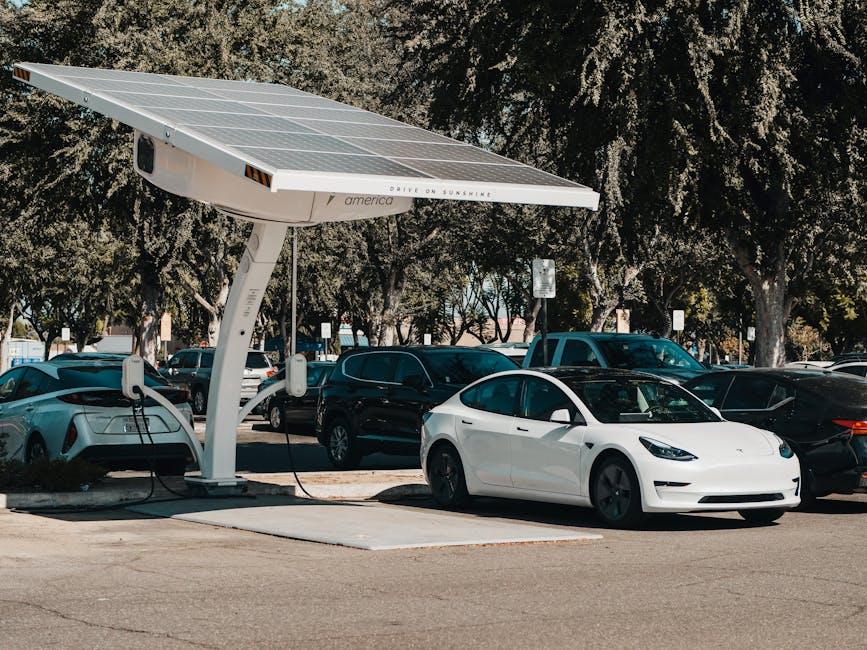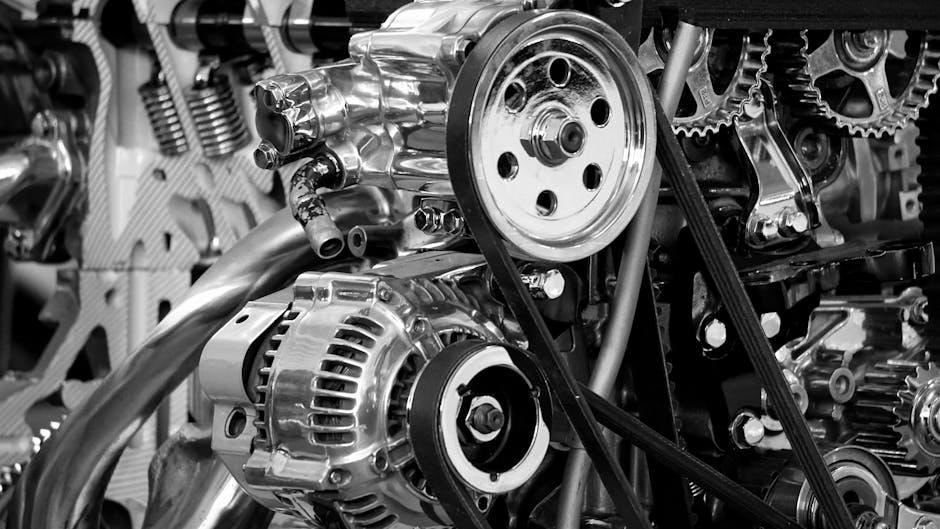When your car refuses to start or suddenly powers down while driving, the root cause often points to two critical components: the alternator and the battery. Though both are essential to your vehicle’s electrical system, the symptoms of a failing alternator differ in key ways from those of a dying battery. Understanding these differences can save you time, money, and roadside frustration. In this article, we’ll explore the distinct signs that indicate whether your car’s trouble lies with a bad alternator or a battery, helping you diagnose the problem with confidence.
Table of Contents
- Identifying Warning Signs of a Failing Car Alternator
- Common Symptoms That Point to a Weak or Dead Battery
- How to Differentiate Between Alternator and Battery Issues
- The Impact of Electrical Problems on Vehicle Performance
- Step-by-Step Troubleshooting Techniques for Charging System Faults
- When to Seek Professional Help and Prevent Costly Repairs
- Q&A
- Final Thoughts

Identifying Warning Signs of a Failing Car Alternator
When your car’s electrical system starts acting up, it’s crucial to differentiate whether the alternator or the battery is the culprit. One key sign of a failing alternator is the presence of dimming or flickering headlights and dashboard lights, often most noticeable when idling or at low speeds. These symptoms occur because a weak alternator struggles to generate sufficient electrical power. Another red flag includes a strange, persistent grinding or whining noise coming from beneath the hood, which indicates worn-out bearings or internal alternator damage. Additionally, frequent stalling or difficulty starting the engine—even when the battery is relatively new—can signal a failing alternator struggling to maintain proper voltage.
Watch out for these common warning signs that often get overlooked:
- Battery warning light glows on the dashboard even after jump-starting.
- Electrical components malfunction, such as power windows and radio behaving erratically.
- Burning rubber or electrical smell, indicating belt slippage or overheating alternator parts.
| Symptom | Likely Cause |
|---|---|
| Dimming Lights | Alternator output dropping |
| Battery Warning Light | Alternator failing to charge |
| Strange Noises | Alternator bearing wear |
| Frequent Stalling | Power supply interruptions |

Common Symptoms That Point to a Weak or Dead Battery
When the battery in your car starts to fail, you’ll often notice a few telltale signs that signal it’s time for attention or replacement. A dimming dashboard, sluggish engine crank, and electronic accessories malfunctioning are the most common. These symptoms occur because the battery can no longer provide the consistent voltage needed to run the vehicle’s electrical systems effectively. You may also observe a strong smell of sulfur or rotten eggs, indicating acid leakage or corrosion on battery terminals.
Other signs that suggest a weak or dead battery include:
- Slow engine start: The engine hesitates or turns over slowly when you turn the key.
- Frequent jump-starts: Repeated need for external power assistance.
- Dashboard warning lights: Battery-shaped or check engine lights illuminating unexpectedly.
- Electrical issues: Lights dimming or flickering during acceleration or power usage.
| Symptom | What It Means |
|---|---|
| Slow Crank | Battery struggling to supply enough power |
| Corroded Terminals | Battery acid leakage affecting connections |
| Warning Lights | Electrical system irregularities detected |
| Dim Lights | Voltage drop under load |

How to Differentiate Between Alternator and Battery Issues
When your car starts showing signs of electrical trouble, pinpointing whether the alternator or the battery is at fault can save you time and money. Typically, if the dashboard lights flicker or the vehicle struggles to start but then runs fine once started, you might be facing a battery issue. Batteries fail to hold a charge over time, leaving you with dim headlights, slow engine crank, or the need for frequent jump-starts. On the other hand, an alternator problem often reveals itself by a dying engine while driving or a rapid loss of interior electronics power, signaling that the alternator isn’t recharging the battery properly.
Here’s an easy way to differentiate the symptoms:
- Battery issues usually manifest as difficulty starting or intermittent power failures when the vehicle is off.
- Alternator troubles often produce warning lights on the dashboard and electrical glitches that worsen with engine speed.
| Symptom | Battery Problem | Alternator Problem |
|---|---|---|
| Engine Start | Slow crank, won’t start | Starts but dies quickly |
| Dashboard Lights | Dim or no lights at start | Lights flicker or warn |
| Electrical Accessories | Fail when engine off | Fail while engine runs |
Recognizing these differences can provide clarity, allowing you to focus on the right repair before the problem escalates.

The Impact of Electrical Problems on Vehicle Performance
Electrical issues in a vehicle often manifest subtly but can significantly degrade overall performance. When the alternator or battery starts malfunctioning, you might notice the engine struggling to maintain consistent power delivery, causing rough idling or even stalling under load. The electrical system is crucial for powering ignition, fuel injection, and other essential systems, so disruptions can lead to poor acceleration and erratic RPM behavior. Beyond drivability, failing alternators or batteries can also impact the functionality of accessories such as headlights, dashboard indicators, and climate control, which rely heavily on steady electrical input.
Common effects on vehicle performance include:
- Dim or flickering headlights and interior lights
- Unusual dashboard warning lights, especially the battery or charging system indicator
- Slow or unresponsive electrical components (e.g., power windows, radio)
- Engine misfires or surges due to inconsistent current flow
- Difficulty starting the engine or frequent need for jump-starts
| Symptom | Alternator Issue | Battery Issue |
|---|---|---|
| Starting Problems | Engine starts but battery warning light is on | Slow crank or no start at all |
| Electrical Accessories | Dim lights while engine runs | Lights remain dim even after engine off |
| Dashboard Indicators | Charging warning light flashes | Battery light stays on |
| Engine Performance | Stalls or rough idle | Normal if battery can hold charge |

Step-by-Step Troubleshooting Techniques for Charging System Faults
Begin your diagnosis by checking the obvious—inspect battery terminals for corrosion or loose connections. A quick visual and physical check can save time before delving into complicated testing. If the battery looks clean and the cables are tight, move on to testing the voltage output with a multimeter. A healthy charging system should read roughly 13.8 to 14.4 volts when the engine is running. If the voltage is below this range, it points towards alternator issues or wiring faults. Additionally, look for dimming headlights, slow electrical accessories, or warning lights on the dashboard as real-time clues.
Use a systematic approach with the following checklist to narrow down the root cause:
- Check battery voltage at rest and while cranking.
- Inspect serpentine belt tension and condition.
- Test alternator output with multimeter and inspect its electrical connectors.
- Scan for error codes with an OBD-II scanner to spot charging system irregularities.
| Symptom | Likely Cause | Troubleshooting Step |
|---|---|---|
| Battery light on dashboard | Faulty alternator | Measure charging voltage; inspect alternator belt |
| Engine cranks slowly | Weak battery or poor connections | Test battery voltage at rest and check terminal cleanliness |
| Dimming headlights at idle | Alternator not generating enough power | Check alternator output voltage at various RPMs |

When to Seek Professional Help and Prevent Costly Repairs
Ignoring the warning signs of a failing alternator or battery can quickly turn into a costly dilemma. When your vehicle begins to show consistent electrical issues like dimming headlights, repeated jump-starts, or a dashboard warning light flickering, it’s a clear signal that professional diagnostics are needed. Attempting DIY fixes on these components often leads to misdiagnosis or overlooked damage, which could escalate problems under the hood. Scheduling a timely appointment with a trusted mechanic ensures proper evaluation and prevents minor faults from snowballing into expensive repairs.
Keep an eye out for these critical signs before consulting a professional:
- Frequent battery drain despite a recent replacement
- Engine stalling unexpectedly during drives
- Unusual whining noises coming from the engine bay
- Non-responsive electrical components, like power windows or infotainment systems
Acting sooner rather than later not only restores your vehicle’s reliability but also protects your wallet from the high costs associated with alternator or battery failure. Remember, the longevity of your vehicle heavily depends on addressing these electrical signals promptly.
Q&A
Q: How can I tell if my car’s problem is the alternator and not the battery?
A: Think of your battery as your car’s initial spark—providing power to start the engine—while the alternator is the ongoing power plant, keeping everything running once the car’s alive. If your car struggles to start but the lights and electronics work fine when running, it’s likely a battery issue. But if your car starts fine and then suddenly everything dims or dies while driving, the alternator might be the culprit.
Q: What are the classic signs of a failing alternator?
A: A failing alternator often makes itself known through symptoms like dimming headlights that brighten when revving the engine, flickering dashboard lights, weird electrical glitches, or a warning battery light glowing on your dash. You might also notice a whining or grinding noise, or strange smells like burning rubber, hinting at a slipping alternator belt.
Q: How do battery problems typically present themselves?
A: Battery issues usually start with slow or labored engine cranking when you turn the key—like the car is struggling to wake up. Other signs include frequent need for jump starts, corrosion on battery terminals, or the car completely refusing to start. Unlike alternator problems, electrical accessories may not function at all since the battery is the primary energy source when the engine is off.
Q: Can I test whether it’s the battery or alternator at home?
A: Yes! One simple test is to start the car and then disconnect the negative battery terminal. If the engine stalls immediately, the alternator isn’t supplying power, meaning it’s likely bad. If the engine keeps running, the alternator is probably fine, and the battery may be at fault. Just be cautious when handling battery terminals to avoid sparks or shocks.
Q: Can a bad alternator damage the battery?
A: Absolutely. A malfunctioning alternator can undercharge or overcharge the battery, which can significantly shorten the battery’s lifespan. Over time, this can leave you stranded with a drained battery that looks like it’s the problem when really the alternator is to blame.
Q: Is it possible for both the battery and alternator to fail simultaneously?
A: While uncommon, yes—it can happen, especially if one problem has been ignored for a while. Worn-out batteries put additional strain on alternators, accelerating their failure. If you’re experiencing persistent electrical problems, it might be worth having both components checked.
Q: When should I seek professional help?
A: If you notice recurring electrical issues, warning lights, or your car’s not starting reliably, it’s smart to visit a mechanic. Diagnosing alternator versus battery problems sometimes requires specialized equipment, and early attention can save you from more costly repairs down the road.
Final Thoughts
In the intricate dance of your car’s electrical system, the alternator and battery each play vital roles, and knowing their distinct symptoms can steer you away from unnecessary repairs and roadside frustrations. Recognizing whether a flickering dashboard or a reluctant start signals a failing alternator or a weakening battery empowers you to address the issue swiftly and confidently. By tuning into these subtle clues, you ensure your vehicle’s heartbeat stays strong and steady, keeping every journey smooth and worry-free. After all, understanding the difference isn’t just about parts—it’s about peace of mind on every mile ahead.
